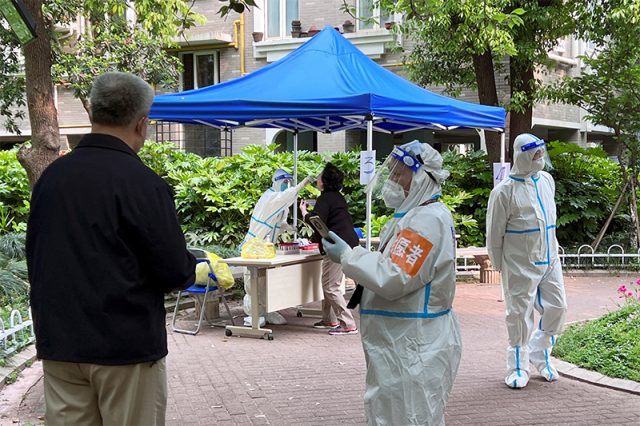
SHANGHAI— The Chinese city of Shanghai on Tuesday pleaded for public cooperation with a massive new push to test most of the population for COVID-19 as it tries to bring community transmission down to zero after nearly three weeks of lockdown.
The plea came as some people refused to join PCR testing queues out of weariness after weeks of such requirements, or fear it puts them at greater risk of infection.
Residents shared stories on social media about busloads of people being taken from their homes and sent into quarantine, including babies and the elderly.
Authorities are under pressure from Beijing to speed up transfers of positive cases and their close contacts to quarantine centers, fuelling fears about measures designed to completely stop the spread of the virus rather than just slow it down.
China, where the coronavirus was first identified in the central city of Wuhan in late 2019, has opted for a “zero tolerance” policy, rather than trying to live with the virus in the community.
“By conducting multiple, consecutive rounds of PCR testing we will be able to dynamically detect positive cases as early as possible, as this will help us to reach zero-COVID at community level more quickly,” city health official Hu Xiaobo said.
Sources have told Reuters that Shanghai aims to stop the spread of COVID-19 outside quarantined areas by Wednesday. The target marked a turning point when achieved by other locked-down Chinese cities, allowing them to ease curbs.
The number of new local transmissions detected on Monday fell to 19,442 from 21,395 the previous day. Shanghai found 550 cases outside the quarantine zones, down from 561 the day before and the fourth consecutive decline.
While Shanghai has not yet said how it will open up, it is working towards that goal by carrying out daily PCR and antigen testing for millions and accelerating quarantine transfers.
China’s COVID elimination strategy requires testing, tracing and centrally quarantining all positive cases and their close contacts. While tens of thousands of people have already been sent to isolation facilities, many more are forced to isolate in their homes due to their proximity to infected people.
The city has eased movement curbs for some people in low-risk areas, but the vast majority of its 25 million population remain in strict lockdown.
Fed up-residents and some businesses in Shanghai have argued that the costs of China’s COVID policy outweigh the benefits, especially as most cases are without symptoms. Some experts have also expressed skepticism.
On April 6, Zhong Nanshan, a respiratory disease expert who helped formulate China’s COVID strategy in early 2020, co-published an English editorial in the National Science Review in which he argued that a prolonged dynamic zero clearance strategy was not feasible.
The South China Morning Post reported that the piece was translated into Chinese and republished by some mainland news websites on Monday, but has since been deleted.
However, Chinese President Xi Jinping has insisted that the country stick to the strategy, amid a lack of herd immunity and a shaky medical system.
In line with this, the city is speeding up transfers of patients to quarantine centers such as converted schools and apartment blocks which have been criticized by patients as crowded and unsanitary.
Some photos posted on social media showed elderly people in wheelchairs, masked up and in protective gear, arriving by bus outside a quarantine center. Others posted stories of how their relatives, some of whom they said were over 90 or babies, were taken to makeshift hospitals in the middle of the night.
Reuters was not immediately able to verify these photos and videos.
Shanghai also reported that seven people infected with COVID-19 died on Monday, all of them elderly and with underlying health conditions, taking its total death toll for the current outbreak to 10.
—Reporting by Brenda Goh, Beijing and Shanghai Newsrooms; editing by Stephen Coates and Nick Macfie









